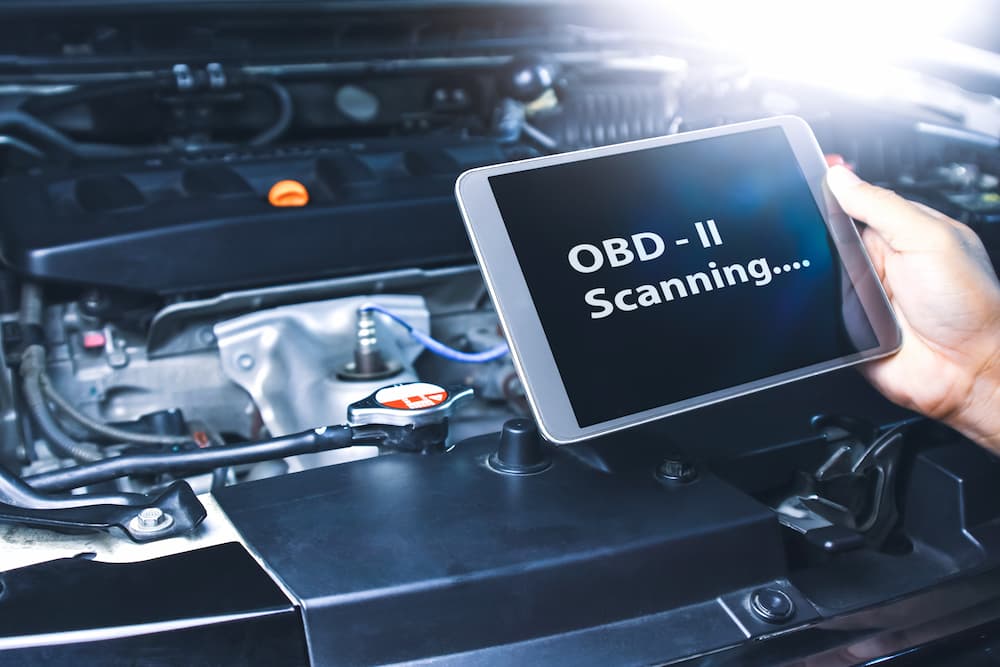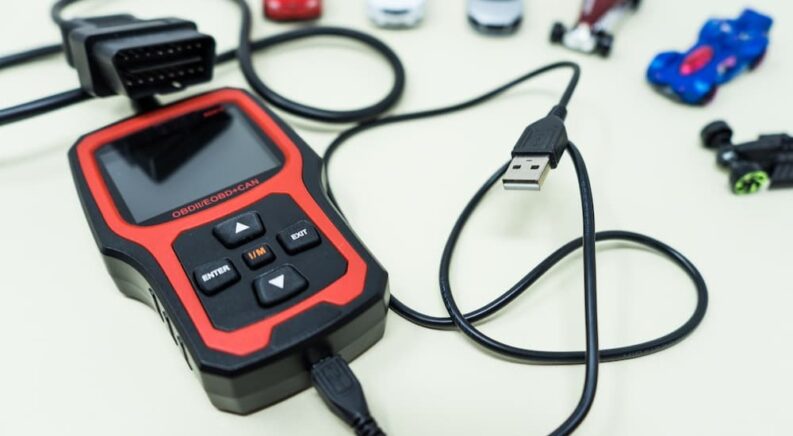We’ve all been there: you’re cruising down the road, enjoying a pleasant drive, when suddenly a glaring orange light pops on the dashboard. You spot that familiar engine icon, and suddenly your mind is racing with any number of disastrous possibilities. Is the engine about to blow? Has that squeaking sound always been there? When was the last time I got the oil changed? The check engine light can strike fear into the heart of even the most experienced driver, turning a leisurely drive into a desperate search for the closest service station.
In some ways, the whole check engine system seems a bit outdated. In an age when our vehicles can navigate across the country, detect pedestrians, and automatically park, it’s a little odd that the system hasn’t evolved past a simple engine icon that does little to clue us into the actual problem. Despite all the advancements we’ve seen in the industry, the average driver is still at the mercy of their local mechanic or dealership when faced with a check engine light. The issue becomes all the more egregious when you learn that, with some exceptions, that “expert consultation” boils down to little more than a technician plugging an onboard diagnostic (OBD2) scanner into an easily accessible port, reading off a five-digit diagnostic trouble code (DTC), and charging you anywhere between $50 and $100 for the privilege.
Luckily, the check engine racket has become a little more democratized in recent years, with a number of brands introducing affordable OBD2 scanners for the average driver. Today’s consumer-grade OBD2 scanners can be broken down into three general categories, which are separated by price and functionality. From entry-level units designed to pair with a smartphone to full-fledged diagnostic tools that do much more than simply read DTCs, there are plenty of options out there to fit every driver and budget. Read on as we break down the three major categories of OBD2 scanners, describe how they work, and share our tips for some of the best products on the market.

Bluetooth OBD2 Scanners
At the entry-level, you’ll find the newest addition to the OBD2 lineup: the Bluetooth-based OBD2 scanner. These handy little scanners are an affordable alternative to the traditional OBD2 scanner, costing between $40 and $120 for some of the more premium options. This low price is due to the fact that, unlike other OBD2 scanners, the Bluetooth products don’t have their own display screen. Instead, they pair with an app to display all the relevant info on your smartphone.
At their most basic, these scanners can read and display DTCs, translating the five-digit code into plain English based on your specific make and model. They can display live data, and some of the more expensive Bluetooth scanners can also monitor the airbag, ABS, and TPMS, as well as perform emissions tests and smog checks. The apps often provide tips and guides for the DIYer and a color-coded scale to let you know how serious a DTC-related issue might be.
Some Bluetooth scanners include a premium subscription service that allows drivers to get real-time advice from certified mechanics, as well as repair cost estimates and more. Ideal for the fledgling at-home mechanic, Bluetooth scanners are both easy to use and very affordable.
Our Pick: BlueDriver Pro Scan Tool
The BlueDriver Pro Scan Tool is a Bluetooth OBD2 reader that outshines many of its more expensive display and diagnostics counterparts. Unfortunately, this kind of functionality comes at a premium, with the Bluetooth scanner ringing in at $120. That said, it doesn’t require a monthly subscription like some other Bluetooth-based scanners, which increases its value over the long term. What do drivers get for the price? A lot, if we’re being honest.
The BlueDriver Pro Scan Tool is very easy to use and includes a well-designed app that’s both easy to navigate and thorough. From reading and interpreting engine codes to monitoring vital vehicle systems, running emissions and smog checks, and displaying real-time engine data, the BlueDriver app is a gold mine of information. The scanner can even display expected DTCs based on the make and model, giving drivers a chance to spot potential issues well before they actually arise. The BlueDriver app automatically updates, meaning you’ll always be working with the latest information whenever you go to diagnose a problem.
Plaudits aside, we know that the $120 price tag might be a non-starter for some drivers, which is why we’ll also mention a solid budget option in the Fixd OBD2 scanner. Available for just $40, this minimalist take on a Bluetooth scanner is little more than a white rectangle that plugs into your OBD2 port with a connected app on your smartphone. The Fixd scanner holds its own in terms of functionality, displaying DTCs, recommending repairs, and allowing for some data collection.
However, many of its handier features are hidden behind a subscription-based paywall that’ll cost an additional $70 per year. That subscription does come with a mechanic’s hotline, cost estimates for fixes, issue forecasting, and an emissions precheck feature, but if you’re already plunking down the extra $70, you might as well go with the BlueDriver Pro Scan Tool from the start.

Display OBD2 Scanners
Before the advent of Bluetooth scanners, display OBD2 scanners––also known as code readers––were the cheapest way to see what your vehicle was thinking. Priced between $30 and $50, they still might be cheaper than some Bluetooth options but pack in just as much functionality. Unlike many Bluetooth scanners, display scanners tend to spit out a raw DTC, requiring drivers to interpret the code to determine what the actual issue is.
That said, they often pack other convenient features, including a pre-test smog check, live data, and an Auto VIN function allowing drivers to access data related to their vehicle’s software, performance counters, and engine data. The display scanner’s best trick might be the freeze frame data review, which gives drivers a chance to see the value of different vehicle parameters at the time a DTC was activated. This is handy when you’re trying to isolate the issue that spurred the DTC, saving valuable time that might otherwise be spent on a frustrating trial-and-error process.
Our Pick: Ancel BD310
The Ancel BD310 splits the difference between a Bluetooth scanner and a code reader, using both a built-in screen and your smartphone to display all the relevant OBD2 information. The BD310 ($60) can be used as a standalone unit, but if you want access to more information, a free app allows drivers to access additional data, performance testing, and other diagnostic resources. The BD310 can even make you a better driver, recording data like driving time and distance, driving behavior, and more to help you tackle bad driving habits before they end up costing you.
In addition to the full range of OBD2 functions––like DTC searches, O2 sensor tests, onboard monitor tests, and freeze frame data display––the BD310 has one more trick up its sleeve. The scanner can be used as a supplemental instrument display panel, giving drivers a chance to monitor relevant metrics like engine speed and battery voltage. The BD310 even comes with a heater vent mounting kit and magnetic back plate for easy viewing from the driver’s seat.
Diagnostic OBD2 Scanners
If you’re looking to learn all your vehicle’s deepest, darkest automotive secrets, a diagnostic OBD2 scanner might be the best option. These full-function scanners edge into professional-grade territory, giving drivers a chance to do a deep dive into their vehicle’s diagnostics. Retailing for $70 to $100, diagnostic OBD2 scanners can perform every function of a display ODB2 scanner but add some important features like O2 sensor testing, which is particularly handy when you’re trying to fix a misfire or rough-idling engine.
The tool can perform a full evaporative emissions control systems (EVAP) test––ideal for improving fuel economy or determining whether that check engine light was nothing more than a loose gas cap––as well as a Mode 6 function that performs a full self-test of all non-continuous monitors such as the O2 sensor, EVAP, and A/C to determine whether they’re functioning within the normal parameters. Some even include advanced components and module testing, as well as technical advice, repair tips, and access to technical service bulletins (TSB) that will let you know if your issue is an anomaly or a problem common to the make and model.
Our Pick: Foxwell NT301
When it comes to diagnostic OBD2 scanners, it’s hard to beat the Foxwell NT301. The scanner is not only affordable at around $70, but it also offers a full suite of OBD2 tools, including all ten standard OBD2 service modes. From displaying live data and clearing and resetting DTCs to monitoring the O2 sensors, reading pending codes, accessing vital vehicle information, and more, the NT301 is a well-rounded diagnostic code reader that won’t break the bank.
The NT301 can display the vehicle’s current emissions monitor status, which isn’t a function you’ll find on a majority of diagnostic scanners. The unit will also translate DTC codes, explaining what each five-digit code means in a way the average driver can understand. All-in-all, the NT301 is an exceptional value for the price, giving home mechanics access to pro-level tools for less than $100.
Advanced OBD2 Scanners
There are actually many higher tiers of diagnostic scan tools, but we’ve limited this article to the three lower categories as they’re often the best fit for the DIY mechanic from both a technical and cost perspective. If you want to play with the same toys the big boys use, they’re readily available but be prepared to pay a pretty penny. That’s not to say they’re a bad value: in addition to translating engine error codes, four-system scan tools can also read codes related to the ABS (brakes), SRS (airbags), and transmission and include some basic reset functions.
A full-system scan tool, which typically sells for north of $300, gives drivers the ability to diagnose virtually any system in their vehicle, from the engine to the airbags, tire pressure monitoring system (TPMS), steering and suspension (SAS), and more. Moving up a level, a bi-directional scan tool introduces the ability to re-code the electronic control unit (ECU) and send commands to your vehicle’s systems without using the actual vehicle controls. These features unlock a world of possibilities for the experienced mechanic, allowing them to remotely control different systems, modify the vehicle’s software and even enable or disable certain features. While intriguing, bi-directional can tools aren’t cheap, retailing for several hundred dollars.
Lastly, there’s the full-system scan tool with ECU programming. These tools allow technicians to tweak a vehicle’s software for some very specific applications, which is an important feature for those who regularly engage in track racing or other high-performance endeavors. These tools differ from bi-directional scanners as they include a complex vehicle communication measurement interface (VCMI) that includes everything from a four-channel oscilloscope to a waveform generator, multimeter, and CAN bus tester. They’re amazingly powerful tools that allow a skilled technician to read an engine bay like an open book, but if you’re not familiar with any of the aforementioned terms, it’s probably a sign that you don’t need to invest the thousands of dollars that such a system can cost.
Understand What Your Car Is Telling You
OBD2 scanners give the average driver a chance to play automotive detective, interpreting codes and spotting potential fixes without the hassle and cost of a visit to your local service station. These scanners have come a long way in the last decade, with a new breed of Bluetooth-based products slashing the cost and giving every driver access to information that was once reserved for the pros in grease-stained coveralls.
From entry-level Bluetooth-based products to display code readers and full-fledged diagnostic scanners, these products are making the DIY approach easier than ever. If you’re not mechanically inclined, we’d recommend starting with a Bluetooth-based offering, as they generally do the best job of demystifying the dense jargon of the automotive world. Once you’ve built a little confidence, display and diagnostic scanners can open up a whole new world of possibilities and allow you to develop an understanding of your vehicle that goes well beyond what a simple dashboard light can tell you.

